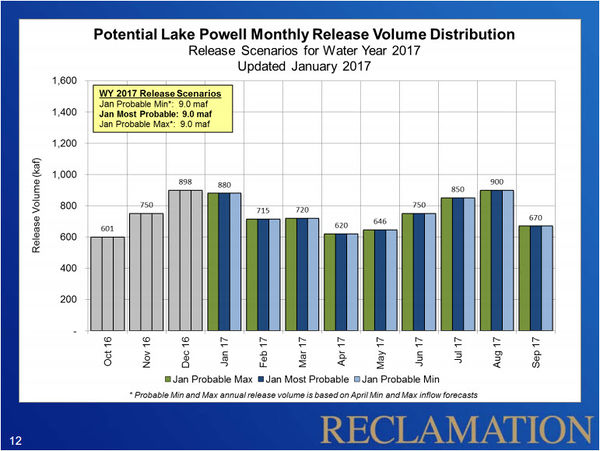- Fact Sheets
- Training
- Knowledge Assessments
- Trivia
- Key Topics
Difference between revisions of "GCDAMP Glen Canyon Dam"
Cellsworth (Talk | contribs) |
Cellsworth (Talk | contribs) |
||
| Line 24: | Line 24: | ||
== '''Operations of Glen Canyon Dam''' == | == '''Operations of Glen Canyon Dam''' == | ||
| + | The Record of Decision (ROD) on the operation of Glen Canyon Dam was signed on October 9, 1996. It stipulated flows at Glen Canyon (via reference to the EIS(1)). A new operating criteria for Glen Canyon Dam was signed on February 24, 1997. | ||
| + | |||
| + | According to the EIS, minimum flows of 8,000 cubic feet per second (cfs) during the day and 5,000 cfs at night were incorporated within the preferred alternative largely to maintaining the food base for the sport fishery (EIS, pg 223). The maximum flow of 25,000 cfs was imposed in order to conserve sediment in the Grand Canyon, especially in the Marble Canyon area. The maximum daily change limitation of 8,000 cfs (during “wet” months) was intended to benefit a variety of resources; sport fish, native fishes, recreation, riparian vegetation and habitat and cultural. The downramp limit of 1,500 cfs was mainly imposed to reduce the erosion of beaches (sand deposits) in the Marble Canyon reach due to rapid leaching of water in the sand (EIS, pg 204). The ROD and operating criteria include “emergency exception criteria” which continued over from “interim flows” as a recognition of the fact that the Glen Canyon Powerplant is connected to an electrical system. [https://www.wapa.gov/regions/CRSP/PlanProject/Pages/glen-canyon-operations.aspx] | ||
| + | |||
| + | == '''Operating tier for WY2017''' == | ||
The operating tier for water year 2017, established in August 2016, is the Upper Elevation Balancing Tier, with an initial water year release volume of 8.23 maf and the potential for an April 2017 adjustment to equalization or balancing releases. Based on the current forecast, an April adjustment to balancing releases is projected to occur and Lake Powell is currently projected to release 9.0 maf in water year 2017. This projection will be updated each month throughout the water year. [http://www.usbr.gov/uc/water/crsp/cs/gcd.html] | The operating tier for water year 2017, established in August 2016, is the Upper Elevation Balancing Tier, with an initial water year release volume of 8.23 maf and the potential for an April 2017 adjustment to equalization or balancing releases. Based on the current forecast, an April adjustment to balancing releases is projected to occur and Lake Powell is currently projected to release 9.0 maf in water year 2017. This projection will be updated each month throughout the water year. [http://www.usbr.gov/uc/water/crsp/cs/gcd.html] | ||
Revision as of 09:16, 16 March 2017
|
Operations of Glen Canyon DamThe Record of Decision (ROD) on the operation of Glen Canyon Dam was signed on October 9, 1996. It stipulated flows at Glen Canyon (via reference to the EIS(1)). A new operating criteria for Glen Canyon Dam was signed on February 24, 1997. According to the EIS, minimum flows of 8,000 cubic feet per second (cfs) during the day and 5,000 cfs at night were incorporated within the preferred alternative largely to maintaining the food base for the sport fishery (EIS, pg 223). The maximum flow of 25,000 cfs was imposed in order to conserve sediment in the Grand Canyon, especially in the Marble Canyon area. The maximum daily change limitation of 8,000 cfs (during “wet” months) was intended to benefit a variety of resources; sport fish, native fishes, recreation, riparian vegetation and habitat and cultural. The downramp limit of 1,500 cfs was mainly imposed to reduce the erosion of beaches (sand deposits) in the Marble Canyon reach due to rapid leaching of water in the sand (EIS, pg 204). The ROD and operating criteria include “emergency exception criteria” which continued over from “interim flows” as a recognition of the fact that the Glen Canyon Powerplant is connected to an electrical system. [1] Operating tier for WY2017The operating tier for water year 2017, established in August 2016, is the Upper Elevation Balancing Tier, with an initial water year release volume of 8.23 maf and the potential for an April 2017 adjustment to equalization or balancing releases. Based on the current forecast, an April adjustment to balancing releases is projected to occur and Lake Powell is currently projected to release 9.0 maf in water year 2017. This projection will be updated each month throughout the water year. [2] |
| --- | --- | --- |
|---|
|
|

